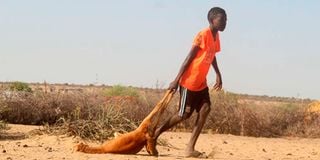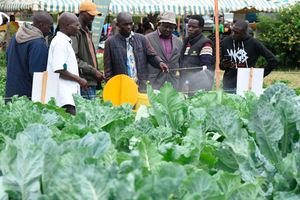Why thousands of Kenyans are sleeping hungry despite ongoing heavy rains

A boy drags away a dying goat at Watalii Village in Illeret, Marsabit County.
What you need to know:
- Almost one million children suffer from moderate and severe acute malnutrition, with 553,365 (65 per cent) residing in Arid and Semi-Arid Lands.
- Additionally, 124,359 pregnant and lactating women are acutely malnourished, with 121,503 from ASAL regions.
Thousands of Kenyans are staring at an escalating food crisis unless food is donated to them, a new report suggests. It says nearly one million children (847,932) suffer from moderate and severe acute malnutrition, with 553,365 (65 per cent) residing in Arid and Semi-Arid Lands (ASAL).
Additionally, 124,359 pregnant and lactating women are acutely malnourished, with 121,503 from ASAL regions, states the Kenya Food Security Steering Group in its latest Short Rains Assessment 2024 report for October, November and December.
This means that as many parts of the country continue to experience heavy rains that have resulted to flooding in some areas, populations in ASALs continue to endure food and nutrition challenges, necessitating the need for humanitarian aid to save lives.
But why is this happening?
Dancliff Mbura, a researcher and communication expert from Action Against Hunger, says the report highlights main drivers of acute malnutrition in the country. “Various factors such as poverty, displacement, conflict and climate-related adversities like droughts and floods contribute to food deficits. Often, these conditions coexist, exacerbating food insecurity in various geographical set-ups, sub-groups or households in the ASAL and other areas of interest like urban poor,” he told Healthy Nation. The researcher added that many communities residing in ASALs regions report elevated levels of poverty and climate-related adversities, impacting both food production and purchasing power.
“This hampers the realisation of the four pillars of food security—accessibility, availability, utilisation and stability—resulting in severe food insecurities that deepen disparities in household food consumption, particularly affecting women and children and escalating rates of malnutrition.”
Mr Mbura noted that the ASAL communities are grappling with the aftermath of six consecutive failed rainy seasons, resulting in widespread loss of livelihoods, including livestock and crops, thereby aggravating food insecurity. “The adverse effects of the Covid-19 pandemic, coupled with locust infestations, further compounded these challenges, leading to significant disruptions in livelihoods and agricultural activities.
“As of March 2023, more than 4.4 million individuals were classified within IPC 3 or higher — faced high levels of acute food insecurity — necessitating food and other humanitarian interventions,” said Mr Mbura.
This figure decreased to 2.8 million by August 2023, and the recent Short Rains Assessment report of February 2024 indicates that 1.9 million people are currently classified within IPC 3. “
He highlighted that while improved rainfall during certain periods contributed to this reduction, El Niño-induced flooding during the latter part of 2023 nullified these gains, resulting in displacement, property damage, and loss of livelihoods for over 500,000 households predominantly in ASAL areas. This, according to Mr Mbura, led to heightened humanitarian needs, with reports of increased waterborne diseases, particularly diarrhoea, worsening the situation.
In ASAL counties, milk production remains severely compromised, with livestock yet to recover from the effects of prolonged droughts and floods. Disease outbreaks further impacted milk production and exacerbated inequalities in access to resources, with women and children being the most affected. He pointed out that currently, Turkana, Marsabit, Mandera, Wajir, Garissa, Isiolo and Tana River counties, along with Tiaty East and West sub-counties of Baringo, are among the ASAL areas classified within IPC 3 or higher.
These counties, he noted, also exhibit alarmingly high levels of malnutrition, particularly among children and pregnant women, with a substantial number classified with Global Acute Malnutrition above serious levels (GAM >10 per cent) increasing their susceptibility to illness or death.
Currently, Garissa, Wajir, Isiolo Baringo, West Pokot, Tana River Samburu and West Pokot counties are classified as serous level (GAM 10 – 14.9 per cent) while Turkana, Baringo Marsabit and Mandera are classified in Critical level (GAM 15 – 29.9 per cent).
This is why despite marginal improvements in nutrition levels across the counties, the overall nutritional status remains stagnant at high levels or worse state, underscoring the urgency for increased investments to avert a humanitarian crisis.
“Key drivers of malnutrition include inadequate dietary diversity and poor hygiene practices, compounded by unfavourable trade terms, escalating food prices and inadequate multisector interventions.
“Addressing these challenges requires comprehensive support to enhance food accessibility, reinforce community-level nutrition services, and promote behavioural change communication initiatives to improve hygiene and nutrition practices,” he said.
He added that with enhanced rainfall and floods as is being forecasted by meteorologists, there is urgent need to strengthen contingency planning, early warning systems, and prompt responses to prevent a humanitarian crisis.
“There is need to ensure resources are made available for contingency and response actions. “





